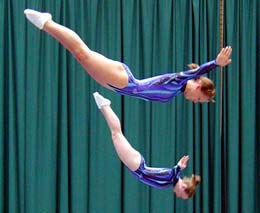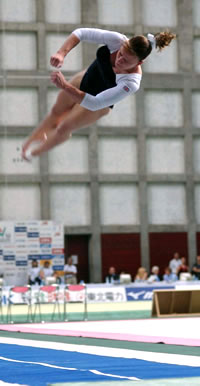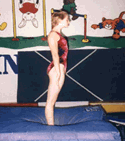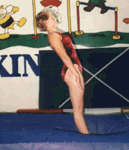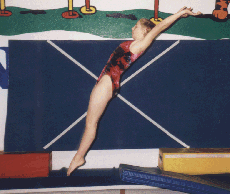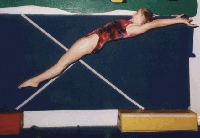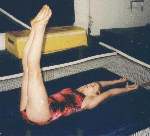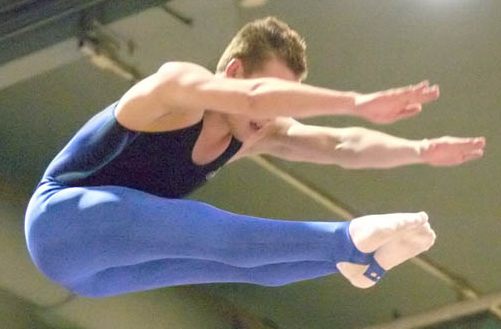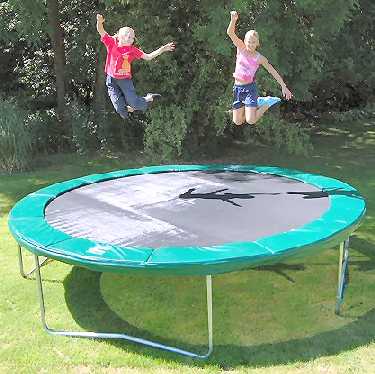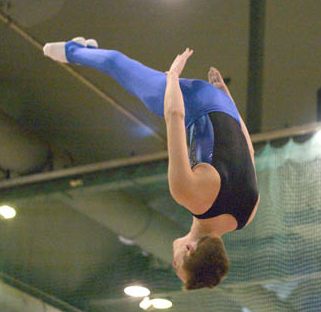|
|
||||||||||||||||||||||||||||||||||||||||||||||||||||||||||||
|
HOME | BIOLOGY | BOOKS | FILMS | GEOGRAPHY | HISTORY | INDEX | INVESTORS | MUSIC | NEWS | SOLAR BOATS | SPORT |
||||||||||||||||||||||||||||||||||||||||||||||||||||||||||||
|
Trampolining is actually a gymnastics discipline. It was conducted as a separate sport for many years, then became an international Olympic event in 2000. Bouncing about on a trampoline is healthy and fun for all ages. Apart from firming body tone, this exercise helps develop spatial awareness which is a useful basic training for all sports containing acrobatic movements.
Trampoline symmetry
Trampolining (individual or synchronized) is an elite sport, a discipline symbolizing freedom, flying and space, harmoniously associated with boldness, elegance and precision. The multiple somersaults and twists at a height of about 8 meters require a fine technique, perfect body control and most aesthetic movements. Trampolining is spectacular, it combines courage, elegance and agility. Below are the records for 2000 and 2004.
Gymnastics - allied disciplines
Is the trampoline for you? YES, trampoline is for everyone
This article may be used as a general teaching aid for competitive trampoline. It is a tool that can be helpful for both men and women's artistic gymnastics programs. Trampoline is helpful for improving and making gymnastics safer.
Physical Preparation
The beginning preparation for leg strength includes: running and jumping on both legs or on each leg, skipping, and chasses; all done on the floor. Work straight body holds between mats on both stomach and back to strengthen the middle body, both front and back.
By using a small jogging trampoline as a station, arm positions, body tightness, push through the toes, and inner thigh strength can be developed.
Using a theraband station to develop the push through the feet is also beneficial. The gymnast assumes a pike position, lying on her back and places both feet on the theraband. Then the gymnast flexes the feet, then points the feet with toes still flexed. Then the gymnast points the toes, flexes the toes, then returns to flexed feet. Repeat this sequence 10 times.
In the early stages of learning to bounce, all jumps on the trampoline are done with arms in various positions. The first position is straight up with the shoulders covering the ears. The second position is straight forward. The third position is out to the side, and finally with the arms straight down. In all of these positions, the arms are straight and remain straight. They do not bend when the body feels the G-force as the feet touch. The body is very tight and the focus is on a tight body during the bounce. This is very important for creating the strength and forming the body for beginning to advanced skills. The gymnast must keep the hips flat in all jumps, body straight and flat. When the arms are up, this is the take off position, the beginning and ending position. We call this the #1 position: hips flat, hands in the same direction as armpits, and fingers joined together. It is important to form the body from day one.
The take off position is a straight body, so train this position against the wall: arms up covering the ears, rib cage in, back pressed against the wall. Everything is very tight and stretched. Every body part is as flat as possible, pressed against the wall. A jogger gym can be used as a station for extra preparation and as a first experience to jumping. During the first experience, hold the child under the armpits at first, and actually do the jumping for them. Then progress to holding their hands. These drills will be covered in a future video for preschoolers.
Develop leg strength by jumping on one leg on the jogging trampoline and the fast track. However, because of the slowness of the trampoline, do not ever bounce on one leg at a time on the trampoline because this could cause injury to the knee. Work the positions on the floor as statues before even attempting them on the trampoline. Try to pull legs apart and push at different body parts to help the gymnast understand the tightness of each skill.
THE STATUES ARE:
Seat Drop: The gymnasts sits in a pike, legs together, and toes pointed, back flat, hands on the floor by the hips, fingers facing the feet.
Hands and Knees: The gymnast is on hands and knees with a 90-degree angle in the armpits. The back is flat, neck is straight, with the face toward the floor. Head is in the military chin position.
Back Drop: The gymnast is lying on the back with head on the floor, arms straight on the floor, covering the ears with the shoulders and legs straight up at 90 degrees.
Front Drop: The gymnast is lying in a prone position, flat from her knees to her chest. The knees are bent 90 degrees with the feet aiming up to the ceiling. Elbows are down on the floor, with hands on the floor, slightly in front. The neck is straight with the face looking toward the floor. Head is in the military chin position.
Flat Back: This position is the #1 position done on the floor with the arms extended both above the head and also beside the body.
The head position is important at the very beginning stages of trampolining. Do not throw the head back by lifting the chin because for every action, there's a reaction. This head action causes the lower body to go in the opposite direction. If the head is down, with chin on the chest, the gymnast is dragging the head. Since head weight is 7 to 9 pounds, the head in this position acts as an anchor. So, we have a simple drill for the head. Stand in front of a soft mat and stick the chin out. Then by pulling the chin in (military chin), lead with the head and fall flat on the back. Stay straight and tight with no bend in the hips. Let the head create the movement. This is called the Huff and Puff drill because the young gymnasts stand in front and huff and puff to blow each other down.
This drill leads into the back drop. The back drop, if done correctly, is a skill that helps create correct backward rotation for the future. It also develops the correct habit for the head. In this drill, the gymnast stands in front of a tall soft mat with the arms extended straight above the head, with shoulders covering the ears. The gymnast could stand at the edge of the pit with a mat in the pit, or in front of a mat on the trampoline, as depicted in picture #8. The gymnast jumps backwards with body straight and tight and feels the 45-degree angle before lifting the legs to a 90-degree angle. As the legs are lifted, do not lift the upper body, but rather continue to let the head and upper body go in the same direction. The head must touch the bed at the same time as the back when arriving at the back drop position that was trained on the floor as a statue. This is the first step in training the X-Factor. The body is trained to see and feel itself through the 45 degrees, which in all directions forms an X.
To create forward rotation without piking first, have the gymnast stand on a mini-tramp with her back toward a soft mat that is approximately the same height or slightly lower than the mini-tramp. A coach or teammate stands in front of the gymnast holding her hands, ready to support her upon landing. The gymnast simply jumps backward onto the mat to finish in a stand with a forward incline of 45 degrees without piking. Remember, whether jumping forward or backward, it's up and through the 45 degrees of the X in both. This drill can also be performed on the floor to assist the gymnast in learning to jump backward, keeping the hips flat and arriving at the 45 degree angle. You can vary this drill by jumping backward off low mats to finish at a 45 degree angle.
The above is the first step in learning a front drop. But in order to create the action without bending the hips, the following drill must be added: practice bouncing on hands and knees, then go down to the front drop position prior to attempting a front drop from a standing position or a bounce.
The best way to teach trampoline is by setting up stations. You can set up 3 rotations that include drills for a specific trick or have a station for strength, such as theraband or have a station on a soft mat to work body positions. In a later article, specific lesson plans for creating stations will be presented.
Remember to always check the safety of the trampoline and surrounding area. Remind the gymnast that only one person at a time can jump on the trampoline. A coach must be present at all times when the gymnast is on the trampoline. The gymnast must never jump onto the trampoline when the rotation is over-always walk around the trampoline, never on the trampoline (if class has been given on an in-the-ground tramp.) Coaches should always stay focused and in control of the group. Coaches should never workout at the same time they are coaching.
TRAMPOLINING IN SCHOOLS
On 2 December 2001 eight pupils from Hailsham Community College in Sussex accompanied by Miss Brady, Mr Webster and Karen Street, travelled to Haywards Heath to compete in the schools first trampolining competition.
The standard was exceptionally high with members from the Great Britain Trampolining Squad competing. All the girls involved have been working hard towards the competition by attending an after school trampolining club. The girls competed in two different age groups, the under-14 and the under-18 sections. Each of the competitors had to perform a compulsory 10-bounce routine, after which they were rank ordered. They then went on to perform their voluntary routine where they were given the option to be creative. Most of the girls chose to perform their first routine with slight adaptations.
All of the girls performed extremely well and gained the valuable experience of taking part in their first competition. From this start the JUMP club now attracts many more students who put on a show each year, including dance and synchronised trampolining. The college has since obtained Sports College & Business and Enterprise status and academic awards. Hailsham Community College is situated in the market town of Hailsham, East Sussex.
School Contact Information:
Principal: Mrs Lesley Farmer
Telephone 01323 841468 FAX 01323 848900
Postal address: HCC, Battle Road, Hailsham, East Sussex, BN27 1DT
General
Information: hcc@hailshamcc.e-sussex.sch.uk
Trampolining tuck
Schools Regional Championships - December 5th 2005 In
December 2005 Hailsham
The day was not without its hitches first all our entries were lost and then Kirsty had an unfortunate accident dismounting the trampoline. Some took part for the first time and many were trying to beat previous results but our dream of getting a team medal became reality when H.C.C U13s received 3rd overall. Everyone was so proud and it was to be followed by 2nd overall U15, 2nd overall U19 boys and 1st overall U19 girls Sam Welford topped the medals by receiving a 2nd in the individual event.
U19
H.C.C
Christine Medhurst 7th
Ruby Hamadai 8th
Natasha Hodges 15th Hannah Moyo Kate Round Willingdon C.S. Becci Street 23rd, Laura Mathias 33rd
Heathfield
C.C Charlotte Allison 21st
Boys U19 Adam Stoakey 6th Jack Divall 7th Rob Stone 8th
Jason Killeen 9th
U15
Willingdon C.S RebeccDevlin20th Chelsea Dack 28th Bishop
H.C.C
Jaye Hatch 10th
Beth Owen, =15th
Jodie Ansell, 25th Sarah Fitch Hannah Goldsmith
Georgia Dickson
U13
Willingdon C.S Nikki Boniface 27th
Ringmer Hayley
Lloyd 28th
H.C.C
Francesca Elliot 14th
Nicole Strudwick =15th
Abby Melluish =15th Steph Harvey 17th
Kirsty Ansell 19th (first round only)
The
junior entries for the School Regionals this year was bigger then ever.
To be considered for entry you must be U11 and able to perform the set
routine (the same as the older ones do).To be able to perform this routine
well is hard enough but to perform it in front of 400 other people is even
harder. I have only ever chosen
two people before but this year there were 8 and we were all so proud of them.
10
year old Jasmin Eldridge Polegate Primary finished 4th missing the
=2nd place by 0.5 her sister 6 year old Natasha finished 27th,
Beth Elliot from Hawks Farm finished 11th and
Maddie Triggs, Charlotte Yates and Becky Triggs from Willingdon Primary finished 28th, 40th, 44th and Ellie Paine another 6 year old finished 35th
Playland 14 foot Europa Trampoline from Super Tramp
The
Playland Europa trampoline is a high quality, 14ft diameter round
outdoor trampoline offering very good performance and value-for-money.
Playland Trampolines are manufactured by Super Tramp with less
substantial padding which permits a large cost saving while retaining
excellent performance.
USEFUL CONTACTS :
BRITISH GYMNASTICS
Ford Hall
Lilleshall NSC
Newport
Shropshire
TF10 9NB
Tel: 01952 822 300 or 0845 1247129
Fax: 0845 1240989
BRITISH GYMNASTICS
National Development Officer - Disability Ford Hall, Lilleshall NSC Newport Shropshire TF10 9NB Tel: 01952 822 334 Fax: 0845 1240989
SPORTS COUNCILS
England
3rd Floor Victoria House
Scotland
Caledonia House
Wales
Sophia Gardens
Northern Ireland
House of Sport
Trampoline somersault
LINKS :
International Olympic Committee (IOC) - History, profiles, current news, Olympic sports Official site of the 2004 Athens Olympics Olympic Almanac - A lot of hard-to-find information, such as Olympic logos and mascots. Olympic Studies Centre - Includes a directory of Olympic research, forums, and helpful links. U.S. Olympic Committee - An excellent site, full of information on all Olympic sports.
A - Z SPORTS INDEX
WORLD CUP TEAMS 2006
TOP UK FOOTBALL CLUBS
Healthier refreshment for sports
Solar Cola uses a mix of pure cane sugar, guarana and kola nut extracts with B vitamins to keep you at peak performance (according to current research)
|
||||||||||||||||||||||||||||||||||||||||||||||||||||||||||||
|
This website is Copyright © 1999 & 2012 Max Energy Limited, an environmental educational charity working hard for world peace. The names Solar Navigator™,Blueplanet Ecostar BE3™ and Utopia Tristar™ are trademarks. All other trademarks are hereby acknowledged. |
||||||||||||||||||||||||||||||||||||||||||||||||||||||||||||
|
AUTOMOTIVE | BLUEPLANET BE3 | ELECTRIC CARS | ELECTRIC CYCLES | SOLAR CARS | SOLARNAVIGATOR |
||||||||||||||||||||||||||||||||||||||||||||||||||||||||||||
